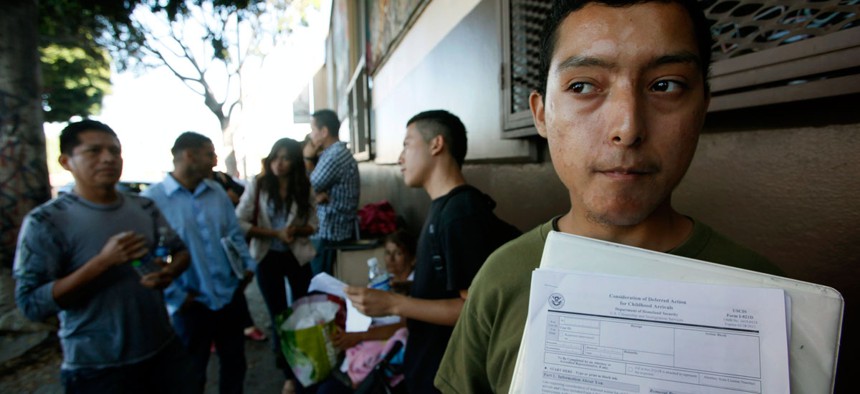White House Dispatches Digital Squad to Salvage Electronic Immigration System

Illegal immigrant Layios Roberto waits outside the offices of Coalition for Humane Immigrant Rights in Los Angeles Wednesday, Aug. 15, 2012. Nick Ut/AP
The Obama administration has dispatched the U.S. Digital Service to study deep-seated problems and experiment with new development techniques for the new system.
A White House rescue team for months has been working behind the scenes to recode an IT project originally intended to computerize the immigration system by 2013.
Had the first try worked, U.S. Citizenship and Immigration and Services caseworkers would be interacting online with each other and the country's roughly 12 million undocumented immigrants. But the “Transformation” program (initial price tag: $536,000) fell to mismanagement and inadequate designs that didn't factor in regional workflow differences.
About $2.6 billion and nearly a decade after conception, the renamed “ELIS” website, or Electronic Immigration System, only makes four types of applications available. Since the opening of Ellis Island, the site's namesake, the process of becoming an American has largely remained paper based.
The Obama administration now says it dispatched members of the U.S. Digital Service, a sort of White House emergency help desk, in July to study deep-seated problems and experiment with new development techniques. The efforts helped ELIS push out Form I-90, an application for renewing or replacing a green card. More than 40,000 I-90 applicants have taken advantage of full electronic filing so far, the administration says.
"We traveled to USCIS operations centers in Kansas City, Missouri and Lincoln, Nebraska, to learn how adjudicators work, how they make decisions, and how they talk about what they do," Vivian Graubard, a Digital Service founding member, said in a blog post Thursday.
The team saw the Band-Aid workarounds personnel had concocted for internal use "that were making it harder to make decisions on requests," she said. After the tours, Digital Service produced "a concept for a design" for ELIS and went back into the field to pick users' brains on the blueprint.
"From this, we started a program of regular intervals of usability testing," Graubard said.
Agency officials tried out the I-90 on 2,000 applications last fall, collected user feedback and then made the application a permanent fixture on ELIS in March. Citizenship and Immigration Services now releases software tweaks every week, she said.
The Digital Service and the agency still have their work cut out for at least the next three years. In February, federal auditors designated ELIS a "high risk" IT project for wasting funding -- most of which comes from fees paid by foreigners -- and for failing to demonstrate it can meet “any” system requirements.
NEXT STORY: Video: Innovation in Data-driven Government



